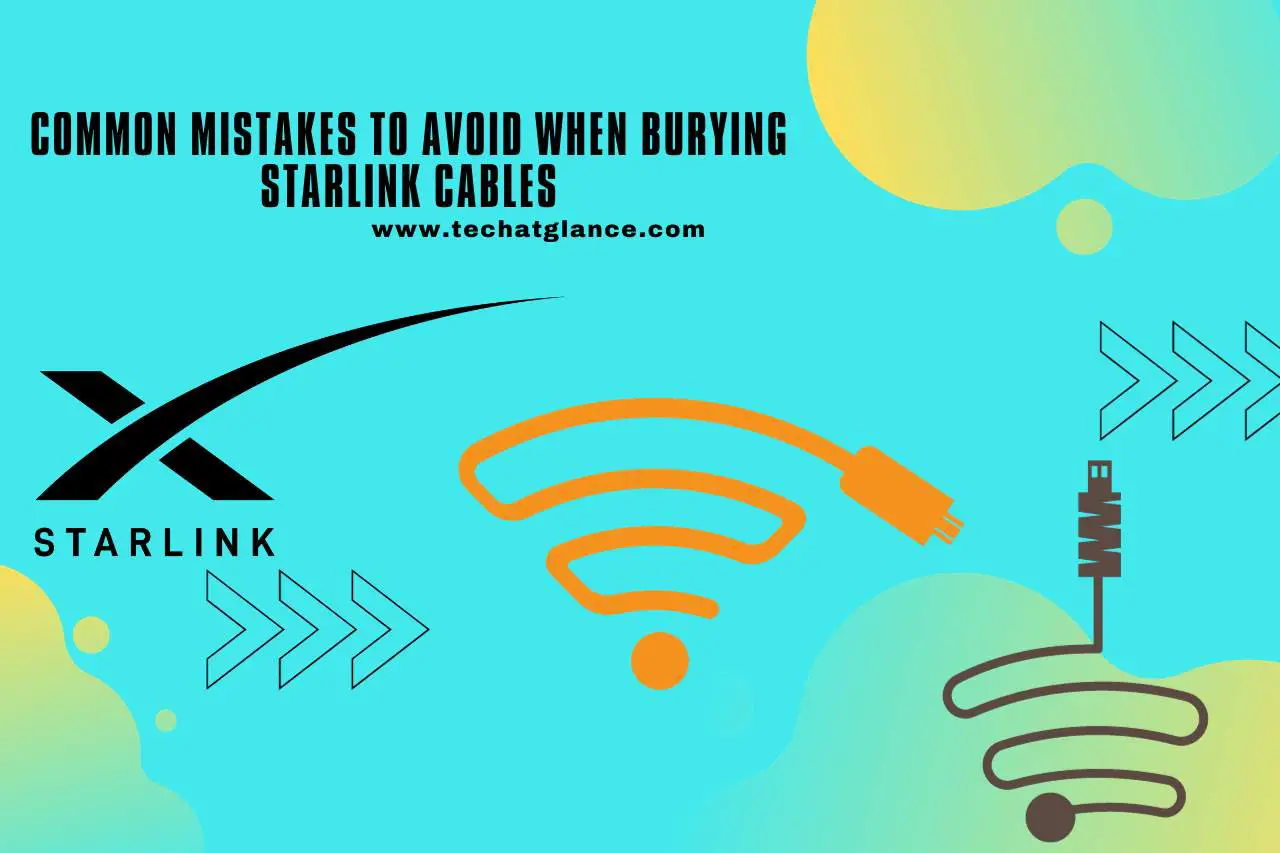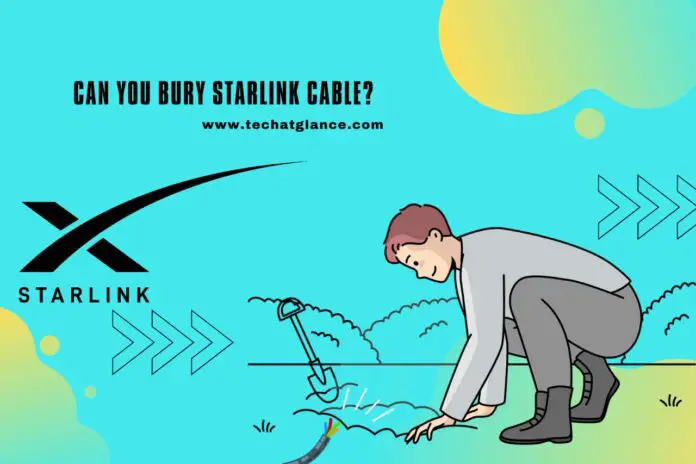“Can you bury Starlink cable?” is a million-dollar question for many satellite internet users among you seeking your streamlined yard and secure connection. Embark on our journey through your do’s and don’ts of burying your Starlink cable, peppered with your expert advice to ensure your robust and discreet setup. From selecting your appropriate protective gear to understanding your local zoning laws, we’ve got you covered.
Can you Bury Starlink Cable? Understanding the Basics
The fundamental requirement for your successful underground installation is ensuring that your cable is protected against your moisture, soil corrosion, and physical damage due to your environmental factors.
Starlink’s standard cables are not designed for your direct burial; they require your extra protection.
This typically involves encasing your cable within your conduit – PVC or metallic – that shields you from the elements.
Additionally, it’s essential for you to adhere to your local building codes and regulations, which often dictate your depth and type of materials used for such installations.
Considering your cable’s importance in maintaining your strong and stable internet connection, professional advice is recommended before you proceed.
Cable manufacturers or your local experts can offer you guidance on your suitable conduits and your correct installation process, ensuring that your signal’s integrity is not compromised.
Before digging, always contact your local utility services to mark any of your existing underground lines.
This step is crucial for both your safety and compliance with your legal standards.
Burying your Starlink cable, while not straightforward, can certainly be achieved with your meticulous planning and appropriate measures to protect your vital link to your satellite internet service.
Protecting Your Starlink Cable for Underground Installation
Protection against your underground elements is paramount. Here’s how you can safeguard your connection to your skies:
Firstly, select your conduit with your robust characteristics suitable for your subterranean environments.
Conduits made from your PVC or rigid metal provide you with a strong barrier against moisture and soil pressure.
Ensure your conduit is of your adequate diameter to accommodate your cable without bending or crimping, as this could impair your signal quality.
Wrap your cable with your waterproof tape designed for your exterior electrical work to add an extra layer of your moisture resistance.
This is particularly important at your connection points, where cables join or enter your conduit.
Additionally, when laying your cable within your trench, fill the space with your sand bedding to act as your buffer, protecting your conduit from your sharp rocks or shifting your soil that could cause your damage over time.
Above your conduit, a warning tape can be your smart addition to alert your future digging efforts to your presence of your cable below.
Finally, grounding your system according to your electrical codes mitigates potential damage from your electrical surges.
By taking these protective steps, your Starlink cable will be well-equipped to handle your underground environment, ensuring your reliable and safe connection.
Step-by-Step Guide to Burying Starlink Cable
Burying your Starlink cable is your practical way to protect it from your elements and maintain your clean aesthetic. Here’s your straightforward guide to doing it properly:
- Check Local Regulations: Before digging, check with your local utilities and authorities for any regulations or requirements. Obtain your necessary permits if required.
- Plan your Route: Determine your most direct and least obtrusive path from your Starlink dish to your home. Avoid your areas prone to waterlogging or your heavy traffic.
- Dig your Trench: Excavate your trench approximately 6-8 inches deep, following your planned route. The depth can vary based on your local frost lines and regulations.
- Lay Conduit: Place your conduit rated for direct burial into your trench. PVC or rigid metal conduits are recommended. This will protect your cable from your moisture and pests.
- Thread your Cable: Run your Starlink cable through your conduit, using your guide strings if necessary. Ensure you have no sharp bends or kinks.
- Seal your Ends: Apply weatherproof seals where your cable enters and exits your conduit to prevent water ingress.
- Backfill your Trench: Carefully backfill your trench, ideally laying your warning tape above your conduit before closing it up completely.
- Test Your Connection: After burying your cable, test your Starlink connection to ensure your signal is strong and stable.
By following our steps, you can secure your Starlink cable underground, protecting it from your damage and ensuring uninterrupted service.
Maintenance and Accessibility Considerations for Buried Starlink Cables
When burying your Starlink cables, long-term maintenance and accessibility should be top of mind to avoid your future disruptions. Here’s how you could manage these considerations:
- Accessibility for Maintenance: Choose your conduit with your larger diameter than your cable to allow for your easy removal or replacement. Install your access points or junction boxes at your turns for your easier maintenance.
- Cable Mapping: Keep your detailed map of your cable’s underground path. This is invaluable for any future landscaping and avoids your accidental damage during your digging activities.
- Depth Markers: Mark your depth of your buried cable at regular intervals. These indicators serve as your reminder of your cable’s presence and protect it during any of your groundwork.
- Periodic Inspections: Schedule regular inspections of your cable’s exposed endpoints and any above-ground sections. Look for your signs of wear or damage that could indicate your problems with your buried sections.
- Conduit Integrity: Check your integrity of your conduit. Any cracks or damages can allow your moisture and pests to compromise your cable.
- Moisture Checks: In areas with your high moisture levels, consider installing your moisture indicators or performing resistance tests to detect your water infiltration early.
Properly addressing your maintenance and accessibility factors ensures your longevity of your Starlink setup, saving time and resources in your long run.

Common Mistakes to Avoid When Burying Starlink Cables
Burying your Starlink cables is your practical solution to protect them from your elements, but it’s essential for you to sidestep your common pitfalls:
- Insufficient Depth: Not burying your cable deep enough can lead to accidental damage from your routine gardening or landscaping activities. Adhere to your local regulations for your utility line depths to ensure your protection.
- Ignoring Local Codes: Always check your local building codes and utility company regulations before digging. This prevents your legal issues and potential disruption to other underground services.
- Skipping Conduit: Burying your cable without your protective conduit is risky. A conduit shields your cable from your moisture and pests, both of which can cause your significant damage over time.
- No Physical Protection: Without your physical warning tape or your protective cover above your cable, future digging could sever your connection. This tape should read your “Caution: Buried Cable” or something similar.
- Forgetting to Ground: Cables can conduct your electricity from your lightning strikes or power surges. Ensure your cable is properly grounded to prevent your damage to your system.
- Lack of Accessibility: Failing to provide your access points for your potential repairs can turn your simple fix into your major excavation.
By avoiding these mistakes, you can ensure your secure and durable installation of your Starlink cables beneath your ground.
Watch this one,
Video Credits – Hidden Valley Homestead
You May Also Like
- Can you Buy a Second Starlink Router? Optimizing Coverage!
- Does It Matter Which Way the Starlink Router Faces? Facing the Right Way!
- Does the Starlink Router Need to Be Indoors? Choosing the Right Spot!
- Does the Starlink Router have an Ethernet Port? Exploring Connectivity!
- How to Connect Wirelss Printer to Starlink Router? Print Without Hassles!
- Does the Starlink Router Get Hot? (Facts, Myths, and Solutions)
- Why is My Starlink Router Unreachable? Troubleshooting the Mystery!
- What is the Range of Starlink Router? Maximizing Starlink Router Range!
- How Much Power does a Starlink Router Use? (What You Need to Know)
- Can I Use a WiFi Extender with Starlink Router? (What You Need to Know)
- Starlink Router Won’t Power Up – When the Lights Stay Off!
